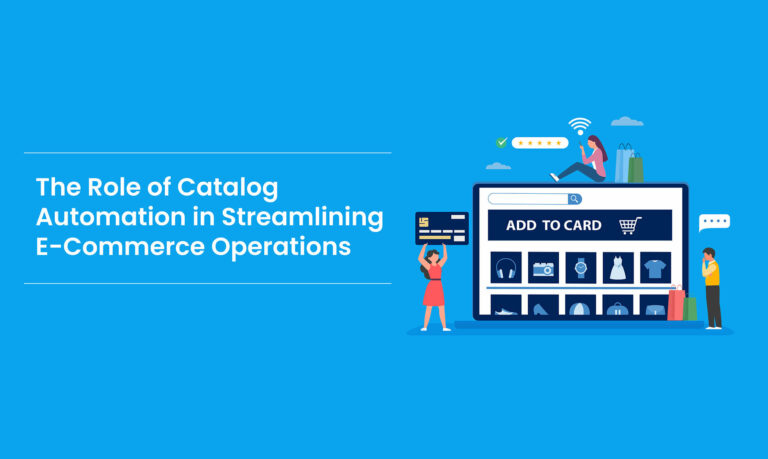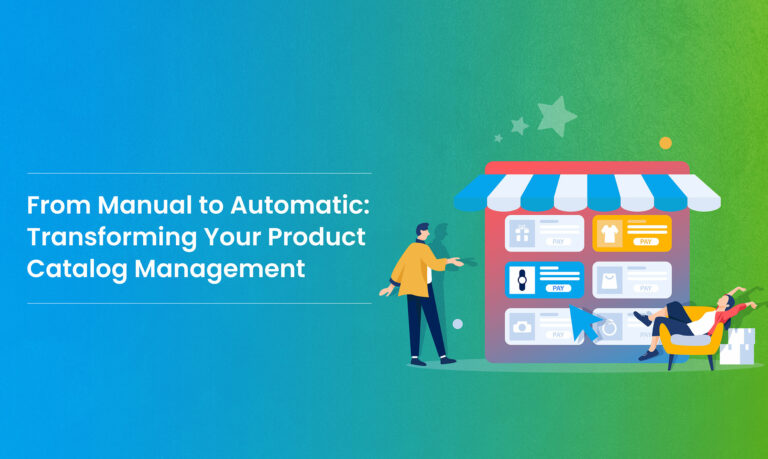Introduction
In the dynamic world of E-commerce, product catalogs are a vital aspect controlling its success. Catalogue Automation becomes a mandatory solution, introducing automated procedures and cutting-edge technologies to simplify the complexities of product arrangement and representation. This broad and intensive scrutiny focuses on the concept of Catalogue Automation, analyzing its effectiveness, and providing insights into implementation principles specialized in this area are an integral part.
What is Catalogue Automation?
Catalogue Automation is an advanced and tactical method that validates automated systems and innovative technologies to carefully refine, reformat, and enhance product catalogs in online retail. Ultimately, this approach focuses on improving operational efficacy through a unified and streamlined management solution for mass product portfolios scattered across various online sites.
Impact of Poor Catalogue Automation
The repercussions of insufficient Catalogue Automation extend across various dimensions, profoundly influencing operational dynamics and customer interactions within the realm of E-commerce:
Inaccuracies and Delays
Insufficient catalog automation often leads to inaccuracies and delays when changing critical product details, resulting in differences and outdated information and confusing the customer.
Disjointed Customer Experience
The inconsistencies and old product information lead to a broken customer experience. This has affected their ability to make good purchasing decisions and leads them to frustration and dissatisfaction.
Decline in Sales
Obsolete or contradictory data about a product immediately reflects on the consumers’ buying patterns, and sales are rapidly diminishing. The inability to give precise and appropriate current facts reduces customers’ confidence.
Operational Inefficiencies
When the level of Catalogue Automation is deficient, manual interventions are required to correct mistakes and update data. This dependence on manual processes causes inefficiency and increases the cost of operations.
Compromised Brand Reputation
The biggest effect is on the brand reputation. Inconsistencies in the product information negatively impact brand quality and trust. A damaged reputation can carry lasting effects, influencing customer faithfulness and brand image.
Best Practices for Catalogue Automation
In the fast-evolving world of E-commerce, Catalogue Automation is critical. This transformative solution simplifies product management while guaranteeing accuracy, efficiency, and improved customer experience across online platforms. Here are the best practices:
Comprehensive Data Standardization: The standardization of product data format is the basis. This guarantees consistency throughout the entire catalog, ensuring the quality and dependability of services for customers.
Real-time Updates: Implementation of real-time automated systems is also crucial. This element ensures that the updated data for product information is reflected as changes in prices and availability, among others, are quickly made.
Dynamic Categorization: Using intelligent dynamic categorization algorithms increases catalog categorization in an intelligent manner. This optimizes searchability and supports a better user interface through easier product discovery.
Multichannel Integration: It is, therefore, necessary to allow smooth integration with different sales channels in the current digital environment. This regulation ensures a standard brand identity on various social platforms, capturing broad audiences and maximizing market penetration.
User-Friendly Interface: It is imperative to prioritize user-friendly automation tools. The intuitive design facilitates navigation, allowing users of various technical skill levels to manage the catalog, thus enhancing productivity.
Workflow Automation: Workflow automation is necessary for making routine processes efficient. The business limits manual efforts through the automation of routine processes, eliminates the possibility of errors, and optimizes catalog management workflow.
Quality Image Management: The visual attractiveness of products requires high-quality images. The quality of images adds to the authenticity behind which items are presented, improving user experience and creating trust.
Advanced Analytics: Using powerful analytics tools enables one to gain priceless insights into the behavior of catalogs, customers, and markets. This data-driven approach allows businesses to make strategic decisions, improve the product range offered, and effectively target marketing campaigns in real-time.
Scalability and Flexibility: Selecting scalable and flexible solutions in automation is future thinking. This guarantees that the system can respond to the developing needs of an increasing enterprise while remaining flexible in reacting to changes inducted by-product catalogs or market demands.
Tools and Technologies for Catalogue Automation
Below are certain important Tools and Technologies for Catalogue Automation:
Product Information Management (PIM) Systems: Centralized platforms are one of the main tools that contribute significantly to data storage, maintenance, and enrichment at the product level. They provide a uniform representation of the brand across different sales intermediaries.
AI Algorithms: One characteristic that makes catalog automation effective is the incorporation of intelligent algorithms. These algorithms facilitate dynamic classification, custom recommendations, and advanced data analytics, enhancing automation effectiveness.
Workflow Automation Platforms: Workflow automation tools simplify routine tasks, reducing manual efforts involved in catalog management procedures. This, in turn, enhances the efficiency of operation and reduces errors.
Multichannel Integration Solutions: Technologies that create perfect connectivity with several sales channels are imperative. These solutions enable a sustainable brand presence in various digital environments, offering unceasing market exposure and potential impact on sales.
User-Friendly Interface Tools: Automating solutions with intuitive interfaces is necessary for them to be widely accepted. Firstly, simplified navigation minimizes the learning curve for users with varying levels of technical know-how, improving overall operational efficiency.
Advanced Analytics and Reporting Tools: Advanced analytics tools integrated into the system give a clear understanding of catalog performance, customer behavior, and market trends. Businesses can make informed decisions to maximize product offerings and improve marketing campaigns through this data-driven approach.
Scalable and Flexible Automation Solutions: Catalog automation tools that are scalable and flexible play a key role. These solutions can easily adjust their systems to fit the developing demands of expanding businesses, allowing for updates in product catalogs and market needs.
Importance of Tools and Technologies for Catalog Automation
Developing modern tools and technologies is crucial for operating Catalog Automation in E-commerce. Such innovative solutions are critical in improving the efficiency, scalability, and flexibility associated with catalog management processes, thus providing businesses an integral competitive advantage within the rapidly changing realm of e-commerce.
Centralized Data Management
PIM (Product Information Management) systems act as centralized data warehouses, helping simplify the management of such information. This makes it possible to maintain uniformity and precision for the entire catalog of products.
AI-Driven Optimization
AI algorithms make categorization better by identifying complex patterns. This leads to better organization of products for increased accuracy and efficiency in searchability and the customer experience.
Workflow Automation
Workflows automate routine procedures that hasten processes. This saves time and minimizes the chances of errors, thus improving overall efficiency.
Scalability and Adaptability
Advanced tools are meant to grow at the same rate as business growth and model-changing catalog demands. This versatility is critical to accommodate expansions, updates, and keeping up with the shifting market patterns.
Competitive Advantage
This integration of advanced tools gives businesses an edge over their competition. The effectiveness of catalog management lies in a competitive, fast-paced online retail environment; It allows businesses to earn and retain customers.
Cataloging Automation with Rubick
Rubick.ai acts as a standard of innovation in catalog automation, empowering businesses to oversee their product catalogs adeptly using sophisticated tools. Delve into the transformative capabilities of Rubick.ai:
AI-Driven Categorization
Using Artificial Intelligence, Rubick.ai provides automatic product classification with advanced algorithms that ensure a precise and dynamic catalog arrangement for better user satisfaction.
Automated Real-Time Updates
While this is one of the biggest highlights, Rubick.ai offers real-time updates to product catalogs automatically so that customers can have current information in a timely manner for enhanced responsiveness.
Multichannel Integration
Rubick.ai effectively integrates with different sales channels, helping to increase its reach and projection of a uniform brand image.
Enhanced Operational Efficiency
From a business perspective, Rubick.ai enhances operational efficiency by automating mundane catalog operations so that resources can concentrate on value-adding strategic initiatives.
Elevated Customer Experience
With AI-based categorization, real-time updates, and multi-channel integration, Rubick.ai positively contributes to increased customer experience, the result of accurate information, and a unified brand image.
Conclusion
As innovations unfold daily within the rapidly changing digital market, Catalogue Automation is a sustainable necessity for E-commerce businesses powered by cutting-edge tools and technology. This terrain can be navigated successfully by adopting these innovations to improve catalog management, enhance customer satisfaction, and sustain competitiveness. The transformative potential of Catalogue Automation, especially in the case of Rubick.ai, shows that it is a core element for success amid fierce competition inherent to the online retail world.

